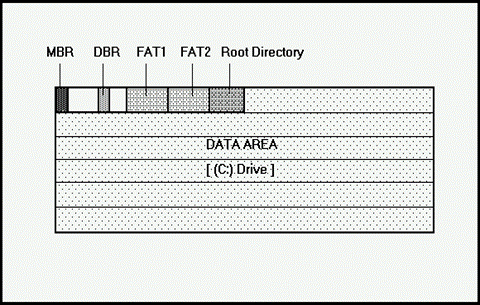Logical Structure of a Hard Disk
Basically, we can divide the logical structure of the hard disk in the following five logical terms:
- MBR (Master Boot Record)
- DBR (DOS Boot Record)
- FAT (File Allocation Tables)
- Root Directory
- Data Area
The following figure represents the conceptual arrangement of these logical terms forming the logical structure of a hard disk:

Master Boot Record (MBR) or Master Partition Table (MPT)
The Master Boot Record (MBR) or sometimes referred as The master partition table (MPT), contains a small program to load and start the active (or bootable) partition from the hard disk drive. The Master boot Record contains information about all four primary partitions on the hard disk drive such as the starting sector, ending sector, size of the partition etc.
The MBR is located at Absolute Sector 0 or we can say at cylinder 0, head 0, and sector1 and if there is more than one partition are present in the disk there are Extended Master Boot Records, located at the beginning of each extended partition volume (See the figure given Next).
The MBR is created on the hard disk drive by executing FDISK.EXE command of DOS. However there are many other software are available to do the same task. Using the FDISK any one of these partition can be made active or bootable.
This allows the boot sector of the active partition to receive the control when the system is started. Since the floppy has no partitions on it therefore there is no MBR on a Floppy.
Since the DOS uses a single upper case alphabet to name a partition, the maximum number of all type of partitions together allowed by DOS is 24, starting from the drive letter C (C:) to Drive letter Z (Z:). Therefore if even there are more than one physical hard disk drives are present, the total number of partitions of all the drives can not exceed 24.
After the Power-On Self Test (POST), the BIOS loads the MBR (Master Boot Record) from the Hard Disk into memory and then executes it. First the MBR checks the Hard disk for an Active Partition, then it loads the DOS Boot Record (DBR) into memory and turns control over to the Operating System Boot code and then the Operating System Boot Record code loads the rest of the Operating System into Memory.
|


